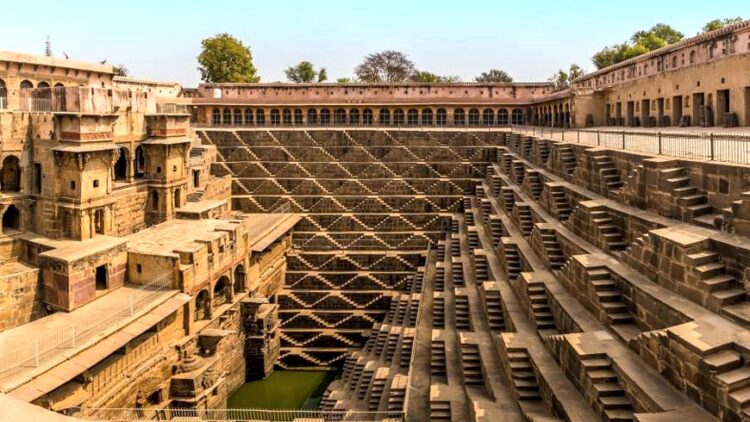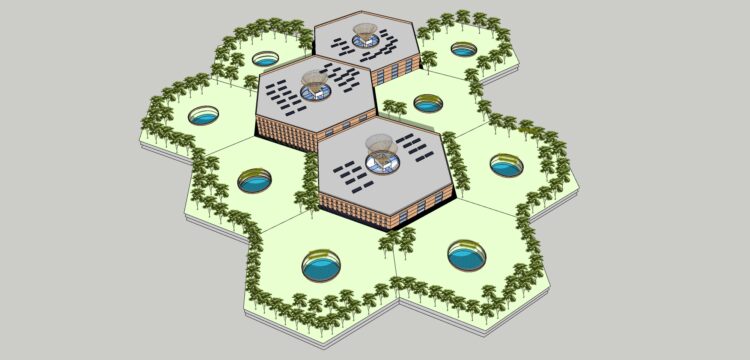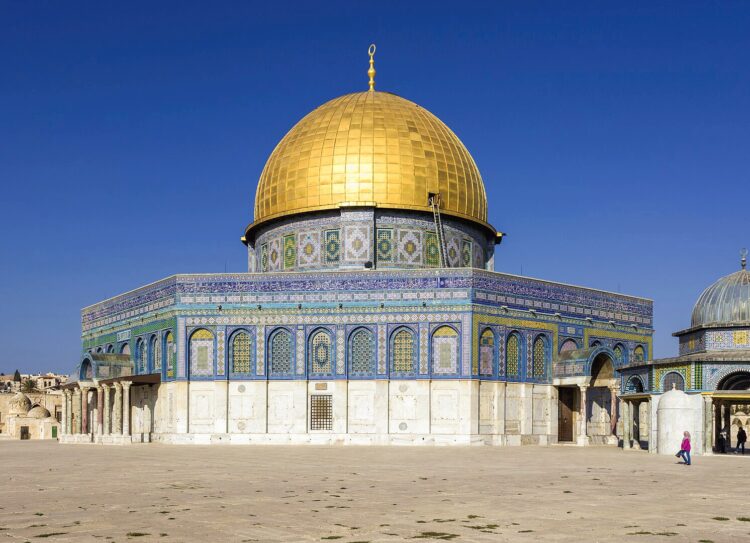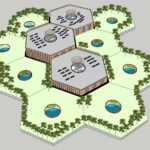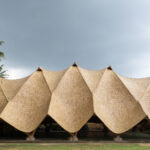Hey there! How is it going? I hope you are doing well these days. In times of climate changes that affects nature as a whole and our overall health, not to mention our access to fundamental natural resources such as water, the ancients from India have an important message for humanity that should not be ignored.
Indian Hindu Cosmology believes that there are cycles of global consciousness with ascension and descend of overall human awareness. Perhaps, that explains the fact that in the past there were civilisations that created marvelous pieces of Architecture and Engineering that we still cannot replicate, or even completely explain today. Some of those structures resist for thousands of years, and sometimes they don’t fit in our current historical narratives, just like the ‘Gunung Padang Hidden Pyramid‘ located in Indonesia. Or even, ‘The Star Forts‘ distributed around the world. The star forts are the main topic of one of our most popular Blog posts, by the way.
A contemporary interesting project that also deals with water management in urban areas, this time in Australia, was the main topic of one of our previous Blog posts. Don’t miss it out on ‘The Drying Green‘.

24.000 years life cycles of Earth according to Hindu cosmology. Source: https://medium.com/@aresynshaw.work/the-4-yugas-the-cosmic-ages-of-the-world-1f2f7fa0eb74
India’s architectural heritage is rich with a myriad of structures that reflect the profound interplay of art, mathematics, and spirituality. Among these wonders are stepwells—intricate, multi-tiered structures designed to store water in arid regions. These stepwells, known as baoris, vavs, or kunds, depending on the region, are not only marvels of ancient engineering but also striking examples of complex geometrical design. When examined through the lens of modern mathematics, stepwells exhibit patterns that can be related to the principles of fractal geometry—a branch of mathematics that studies self-replicating patterns at every scale.
This blog will explore the intersection between Indian stepwells and fractal geometry, revealing how ancient Indian architects may have intuitively incorporated mathematical principles centuries before their formalisation, considering history as we know.
The Ingenious Design of Stepwells
Stepwells date back to around 600 CE, primarily built in semi-arid regions of India such as Gujarat, Rajasthan, and Madhya Pradesh, where water conservation was crucial for survival. The primary function of these stepwells was practical—they stored rainwater and allowed access to water even during dry seasons. However, the ingenuity of these wells went beyond mere functionality.

Stepwells and ‘kunḍas’ in India. Source: https://encurtador.com.br/ActsS
Stepwells are typically built deep into the ground with a series of steps that descend to the water level. These wells often stretch over multiple stories, with terraces, galleries, and platforms flanked by ornately carved walls. The architectural style varies from simple linear designs to more complex patterns, involving square, circular, and polygonal shapes. In some instances, these wells were so elaborately designed that they doubled as social hubs, temples, and gathering places for the community.
One of the most famous stepwells is the Rani ki Vav in Patan, Gujarat, which was designated a UNESCO World Heritage site. In other words, the Rani ki Vav is a multi-tiered masterpiece that descends seven levels deep, with thousands of intricately carved figures along its walls, showcasing both artistic and architectural sophistication.
However, it’s not just the symmetry and repetition in these structures that captivate the modern observer. The patterns and proportions that define these wells also echo concepts found in fractal geometry.

‘Rani ki vav’ stepwell seen from above. Source: https://pt.wikipedia.org/wiki/Rani_ki_kav
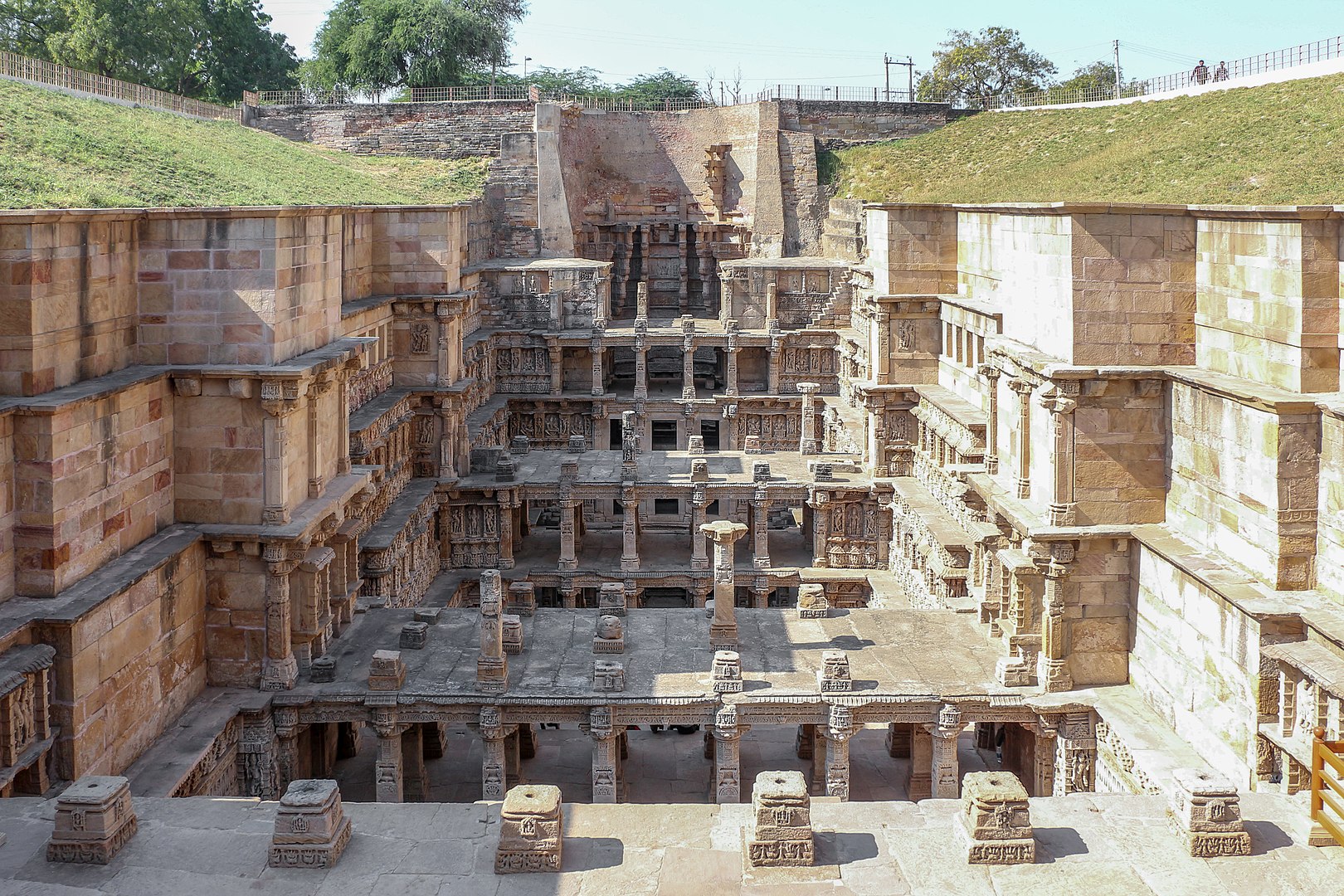
‘Rani ki vav’ stepwell seen from inside. Source: https://pt.wikipedia.org/wiki/Rani_ki_kav
Fractal Geometry: The Study of Self-Similarity
Fractals are geometric figures characterized by self-similarity, meaning that their pattern repeats at various scales. The concept of fractals was formally introduced by the mathematician Benoît B. Mandelbrot in the 20th century. Fractals can describe natural phenomena like coastlines, mountains, and tree branches, where the same structural patterns are replicated in increasingly smaller iterations.
A key feature of fractals is that they are scale-invariant. Whether you zoom in or out, the object maintains its complex structure. While this may sound highly abstract, nature is full of fractal structures. Examples include the branching of trees, the formation of snowflakes, and the spiral structure of galaxies.
Architectural structures, particularly those involving repetitive geometrical patterns, can also demonstrate fractal properties. This is where the connection to Indian stepwells becomes intriguing.

a) 1st Iteration. b) Self-similarity in different directions with different scale. c) Increasing number of angles with center symmetry d) Self-similarity in branches. e) Typical stepwell component parts in longitudinal cross section. Source: https://encurtador.com.br/ActsS
Stepwells and Fractal Patterns
Stepwells, with their tiered, symmetrical, and repeating geometrical forms, can be seen as early examples of fractal architecture. The designs, with descending levels of steps and landings leading into the earth, echo the principles of self-similarity. As one looks down into the well, each level of steps replicates the same pattern as the level above it, maintaining symmetry and proportion. This recursive design gives the illusion that the structure could go on infinitely, much like fractals.
The steps of these wells typically follow polygonal shapes, such as squares and triangles, that repeat themselves on each descending layer. However, in some cases, each level becomes more intricate and complex, but always maintaining the same basic structure. This geometric recursion is a key element in fractal design.

a) Puṣkaraṇis at Hampi, Karnataka. b) Typical plan of water tank at Hampi. c) Lolarka kunḍa, Varanasi. d) Typical Plan of Lolarka kunḍa. Source: https://encurtador.com.br/ActsS

a) Helical step well at Champaner, Gujarat. b) Schematic diagram of Helical step well. c) Mathematical representation of log spiral equivalent to helical well geometry. Source: https://encurtador.com.br/ActsS

a) Chandrasekarapuram, Prakasam, Andhra Pradesh. b) Plan view indicating different levels of decent from ground level. c) Bhadra (4-corners). d) Subhadra (12-corners). e) Nanda (20-corners). f) Paridhi (20 corners + 12 corners in second stage. Source: https://encurtador.com.br/ActsS
For instance, in the Chand Baori, one of the deepest and most famous stepwells in Rajasthan, the intricate arrangement of over 3,500 narrow steps forms a hypnotic, repeating pattern. The staircases zig-zag down 13 stories, with each level mirroring the one above it. The repeated, angular patterns are a perfect visual analogy to a mathematical fractal.
Similarly, stepwells like the Adalaj Vav in Gujarat display multiple levels of pavilions and platforms, where each tier mirrors the one above, while becoming increasingly intricate as they descend.

Chand Baori, Abhaneri, Rajasthan. Source: https://castleandking.com/blogs/unveiling-the-mysterious-history-of-chand-baori-stepwell-an-architectural-wonder-of-india/

a) Chand Baori, Abhaneri, Rajasthan. b) Chand Baori section. Source: https://encurtador.com.br/ActsS

Plan and typical cross section of Chand Baori. Source: https://encurtador.com.br/ActsS

a) Iteration process for self-similarity of different geometrical shapes (Sala 2006). b) Fibonacci iteration for step well geometry. Source: https://encurtador.com.br/ActsS
The Spiritual and Cultural Significance of Fractal Geometry in Stepwells
Fractal geometry is not only an aesthetic or practical feature but also carries deeper spiritual and cultural significance in Indian art and architecture. Indian cosmology and spiritual texts often speak of the infinite, and fractals are a mathematical representation of this concept. The recursive patterns found in stepwells may reflect the Hindu and Jain philosophical ideas of cyclicality and infinity, which permeate much of Indian art and architecture.
The repetition and symmetry in stepwells can also be seen as metaphors for the cyclical nature of time—birth, death, and rebirth. As one descends into the earth, moving from light into darkness, there is a symbolic journey toward the source of life, water, and ultimately, the divine. In Hinduism, water is associated with purification and the essence of life, and the fractal-like descent into the earth mirrors the spiritual journey of seeking truth and enlightenment.

Chand Baori, Abhaneri, Rajasthan. Source: https://www.tripadvisor.com.br

Chand Baori, Abhaneri, Rajasthan. Source: https://www.tripadvisor.com.br
Conclusion
Indian stepwells are stunning architectural feats that continue to mesmerize visitors with their beauty and complexity. The intricate geometrical designs of these wells can be understood through the principles of fractal geometry, demonstrating how ancient architects intuitively captured the essence of self-replicating patterns and symmetry in their work. In other words, this connection between stepwells and fractals highlights not only the advanced mathematical knowledge of ancient Indian builders but also the deep philosophical and cultural meanings embedded in their designs.
The integration of fractal geometry in stepwells serves as a reminder of the timeless human fascination with patterns, symmetry, and the infinite. These structures stand as a testament to the union of art, engineering, and spirituality that characterizes much of India’s architectural heritage. In addition, those structures can also inspire our contemporary constructions in a way that is more integrated to our natural environment and fulfilling of our social needs. ♣
Important Sources:
https://www.researchgate.net/publication/344091221
https://en.wikipedia.org/wiki/Stepwell#/media/
https://medium.com/@aresynshaw.work/the-4-yugas-the-cosmic-ages-of-the-world-1f2f7fa0eb74

